|
Fort DeSoto in fall is rife with tame birds. All the images on this card were created at Fort DeSoto in either late September or very early October. I hope that you can join me there this fall. Click on the composite to enjoy a larger version. Clockwise from upper left to center: Long-billed Curlew, Marbled Godwit, Caspian Tern, Great Egret, Sandwich Tern with fish, Willet, Black-bellied Plover threat display, Snowy Egret, 2-year old Yellow-Crowned Night-Heron, juvenile Yellow-Crowned Night-Heron. |
Fall 2022 Fort DeSoto Instructional Photo-Tour #3
3 1/2 Days: Monday 31 October through the morning session on Thursday 3 November 2022. $1899.00 includes three working lunches. Limit six photographers/Openings: 5.
Fort DeSoto, located just south of St. Petersburg, FL, is a mecca for migrant shorebirds and terns in fall. There they join hundreds of egrets, herons, night-herons, and gulls that winter on the T-shaped peninsula. With any luck at all, we should get to photograph one of Florida’s most desirable shorebird species: Marbled Godwit. Black-bellied Plover and Willet are easy, American Oystercatcher is pretty much guaranteed. Great Egret, Snowy Egret, Great Blue Heron, Tricolored Heron, and White Ibis are easy as well and we will almost surely come up with a tame Yellow-crowned Night-Heron or two. And we will get to do some Brown Pelican flight photography. In addition, Royal, Sandwich, Forster’s, and Caspian Terns will likely provide us with some good flight opportunities as well. Though not guaranteed, Roseate Spoonbill and Wood Stork might well be expected. And we will be on the lookout for a migrant passerine fallout in the event of a thunderstorm or two.
On this IPT, all will learn the basics and fine points of digital exposure. Nikon and Canon folks will learn to get the right exposure every time after making a single test exposure, and SONY folks will learn to use Zebras so that they can be sure of making excellent exposures before pressing the shutter button. Everyone will learn how to approach free and wild birds without disturbing them, to understand and predict bird behavior, to identify many species of shorebirds, to spot the good situations, to choose the best perspective, to see and understand the light, and to design pleasing images by mastering your camera’s AF system. Most importantly, you will surely learn to evaluate wind and sky conditions and understand how they affect bird photography. And you will learn how and why to work in Manual mode (even if you’re scared of it). The best news is that you will be able to take everything you learn home with you so that you will be a better photographer wherever and whenever you photograph.
There will be a Photoshop/image review session during or after lunch (included) each full day. That will be followed by Instructor Nap Time.
These IPTs will run with only a single registrant (though that is not likely to happen). The best airport is Tampa (TPA). Once you register, you will receive an e-mail with Gulfport AirBnB information. If you register soon and would like to share an AirBnB with me, shoot me an e-mail. Other possibilities including taking a cab to and from the airport to our AirBnB and riding with me. This saves you both gas and the cost of a rental car.
A $600 deposit is due when you sign up and is payable by credit card. Balances must be paid by check two months before the trip. Your deposit is non-refundable unless the IPT sells out with six folks, so please check your plans carefully before committing. You can register by calling Jim or Jennifer during weekday business hours at 863-692-0906 with a credit card in hand, or by sending a check as follows: make the check out to: BIRDS AS ART and send it via US mail here: BIRDS AS ART, PO BOX 7245, Indian Lake Estates, FL 33855. You will receive a confirmation e-mail with detailed instructions, clothing, and gear advice. Please shoot me an e-mail if you plan to register or if you have any questions.
|
Clockwise from upper left to center: Long-billed Curlew, juvenile Tricolored Heron, Marbled Godwits, Great Blue Heron, juvenile Pectoral Sandpiper, Wood Stork, smiling Sea Scallop, Ruddy Turnstone scavenging needlefish, Great Blue Heron sunset silhouette at my secret spot, and southbound migrant tern flock blur. |
Up Early, Stay Out Late!
Obviously, folks attending an IPT will be out in the field early and stay late to take advantage of the sweetest light and sunrise and sunset colors (when possible). The good news is that the days are relatively short in early fall. I really love it when I am leaving the beach on a sunny morning after a great session just as a carful or two of well-rested photographers are arriving. The length of cloudy morning sessions will often be extended. Click on the composite to enjoy a larger version.
Spoonbills at DeSoto
Over the past years, Roseate Spoonbills have become regular visitors to Fort DeSoto Park. I know when and where to find them and can teach you to approach them successfully. Do consider joining me on one of the last Fall DeSoto IPT.
What’s Up?
Conditions on the 3rd morning of the 2nd DeSoto IPT were dead-solid perfect. There was a nice wind, more from the east than from the north. The sky was clear as a bell and the sun rose right on schedule as the full moon set in the west. But early on, there were few birds. My morning back-up spot was not great as it can be on occasion, but as usually is the case, there were more than enough birds so that folks learned a ton and everyone made some great images. In the afternoon, we worked the golf course spoonbills again and then headed straight to my secret sunset location where we did well after the sun was down.
For today, I chose six of the 58 morning keepers to illustrate the point that even on most bad days, it is easy to make some excellent images at Fort DeSoto Park. And of course, as you can see by reading today’s blog post, the folks on a BIRDS AS ART Instructional Photo-Tour always learn a ton.
Today is Monday 10 October 2022. Wherever you are, and whatever you are doing, I hope that you too have a great day. This blog post took about three hours to prepare including the time spent on the image optimizations and makes one hundred ninety-eight in a row with a new one.
Please remember to use the B&H and Amazon links that are found on most blog pages and to use the BIRDSASART discount code at checkout when purchasing your new gear from Bedfords to get 3% back on your credit card and enjoy free second-day air FedEx. Please, also, consider joining a BAA IPT. You will be amazed at how much you will learn!
Follow me on Instagram here. I am trying to feature both new and old images, especially images that have not appeared recently on the blog. Or search for birds_as_art.
BIRDS AS ART Image Optimization Service (BAA IOS)
Send a PayPal for $62.00 to birdsasart@verizon.net or call Jim at 863-692-0906 and put $62.00 on your credit card. Pick one of your best images and upload the raw file using a large file sending service like Hightail or DropBox and then send me the link via e-mail. I will download and save your raw file, evaluate the exposure and sharpness, and optimize the image as if it were my own after converting the raw file in Adobe Camera Raw. Best of all, I will make a screen recording of the entire process and send you a link to the video to download, save and study.
Induro GIT 304L Price Drop
Amazingly, we have two, brand-new-in-the-box Induro GIT 304L tripods in stock. They are $699.00 each (were $799.00) and the price now includes the insured ground shipping to the lower 48 states. Weekday phone orders only: 863-692-0906. Order yours here while they last.
Please Remember
You can find some great photo accessories (and necessities, like surf booties!) on Amazon by clicking on the Stuff tab on the orange/yellow menu bar above. On a related note, it would be extremely helpful if blog-folks who, like me, spend too much money on Amazon, would get in the habit of clicking on the Amazon logo link on the right side of each blog post when they shop online. As you might expect, doing so will not cost you a single penny, but would be appreciated tremendously by yours truly. And doing so works seamlessly with your Amazon Prime account.
Please remember that if an item — a Delkin flash card, or a tripod head — for example, that is available from B&H and/or Bedfords, is also available in the BAA Online Store, it would be great, and greatly appreciated, if you would opt to purchase from us. We will match any price. Please remember also to use my B&H affiliate links or to earn 3% cash back at Bedfords by using the BIRDSASART discount code at checkout for your major gear purchases. Doing either often earns you free guides and/or discounts. And always earns my great appreciation.
Brand-New and As-Good-As-Ever Bedfords BAA Discount Policy
Folks who have fallen in love with Bedfords can now use the BIRDSASART coupon code at checkout to enjoy a post-purchase, 3% off-statement credit (excluding taxes and shipping charges) on orders paid with a credit card. The 3% credit will be refunded to the card you used for your purchase. Be sure, also, to check the box for free shipping to enjoy free Second Day Air Fed-Ex. This offer does not apply to purchases of Classes, Gift Cards, or to any prior purchases.
Money Saving Reminder
Many have learned that if you need a hot photo item that is out of stock at B&H and would like to enjoy getting 3% back on your credit card along with free 2nd Day Air Fed-Ex Air shipping, your best bet is to click here, place an order with Bedfords, and enter the coupon code BIRDSASART at checkout. If an item is out of stock, contact Steve Elkins via e-mail or on his cell phone at (479) 381-2592 (Central time). Be sure to mention the BIRDSASART coupon code and check the box for Free Shipping. That will automatically upgrade to free 2nd Day Air Fed-Ex. Steve has been great at getting folks the hot items that are out of stock at B&H and everywhere else. The waitlists at the big stores can be a year or longer for the hard-to-get items. Steve will surely get you your gear long before that. For the past year, he has been helping BAA Blog folks get their hands on items like the SONY a 1, the SONY 200-600 G OSS lens, the Canon EOS R5, the Canon RF 100-500mm lens, and the Nikon 500mm PF. Steve is personable, helpful, and eager to please.
Important Note
As an Amazon Associate, I earn a small percentage when you purchase from Amazon after using any of the Amazon links on the blog (including the logo-link on the right side of each blog post page). My affiliate link works fine with Amazon Prime and using it will not cost you a single cent. Huge thanks, BTW 🙂


Gear Questions and Advice
Too many folks attending BAA IPTs and dozens of photographers whom I see in the field and on BPN, are — out of ignorance — using the wrong gear, especially when it comes to tripods and more especially, tripod heads. And the same is true in spades when ordering new camera bodies or lenses. My advice will often save you some serious money and may help you avoid making a seriously bad choice. Please know that I am always glad to answer your gear questions via e-mail. If you are desperate, you can try me on my cell at 863-221-2372. Please leave a message and shoot me a text if I do not pick up.
Photos from a Bad (?) Morning at Fort DeSoto
|
|
|
This image was created on 9 October 2022 on the 3rd morning of the second Fort DeSoto IPT. Standing on full height, I used the handheld Sony FE 600mm f/4 GM OSS lens and The One, the Sony Alpha 1 Mirrorless digital camera. ISO 800. Exposure was determined via Zebras with ISO on the rear dial: 1/3200 sec. at f/4 (wide open). AWB at 7:59:21am on a sunny morning. Tracking: Zone/AF-C was active at the moment of exposure and performed perfectly. Be sure to click on the image to enjoy the larger version. Image #1: Reddish Egret dark morph dancing with fish |
Dancing Reddish Egrets
By the 3rd morning, some folks were feeling their oats and searched for subjects early on a seemingly perfect morning with few birds. Longtime friend Monte Brown and Nancy Fischer (who had joined us for two pro-rated IPT days on the weekend were with me as the Reddish Egret in my image above did the drunken sailor dance right in front of us in the sweet light.
The Dancing Reddish Egret Lessons
Stay back to avoid cutting off various parts of the subject. If the bird dances towards you and you have a zoom lens, zoom out and get lower if possible. If the bird dances towards you and you are working with a fixed focal length lens, move back by turning around and watching where you are going. When photographing, never walk backwards or you may wind up on your ass (and in some cases, with your gear in the water).
|
|
|
This image was also created on 9 October 2022 on the 3rd morning of the second Fort DeSoto IPT. Standing at full height, I used the handheld Sony FE 600mm f/4 GM OSS lens with the Sony FE 1.4x Teleconverter, and The One, the Sony Alpha 1 Mirrorless Digital Camera.. ISO 800. The exposure was determined by Zebras with ISO on the rear wheel: 1/3200 second at f/6.3 (stopped down 1/3-stop but don’t ask me why) in Manual mode. RawDigger showed that the exposure was dead solid perfect. AWB at 8:27:16am on sunny morning. Tracking: Zone/AF-C with Bird-Eye/Face Detection performed perfectly. Click on the image to enjoy the high-res version. Image #2: Piping Plover juvenile beginning after bath flap |
Bathing Birds
As you have been learning here for years, when you see birds dipping their breasts in the water, they will flap their wings after the bath. When the bird is a state threatened species and the light is sweet, you can make some very good images.
Bathing Bird Lessons
Frame loosely so that you have room in the frame for both the front flaps and the back flaps and then crop as needed to improve the composition. Trust that even if the bird is facing in the “wrong” direction, it will always turn and flap into the wind. With the sun now rising in the east and moving south, the northeast wind was perfect.
|
|
|
This image was also created on 9 October 2022 on the 3rd morning of the second Fort DeSoto IPT. Working from the fishing pier, I used the handheld Sony FE 400mm f/2.8 GM OSS lens and The One, the Sony Alpha 1 Mirrorless Digital Camera). The exposure was determined via Zebra technology with ISO on the Thumb Dial. ISO 500. 1/1250 sec. at f/3.2 (stopped down 1/3-stop) in Manual mode. When evaluated in RawDigger, the raw file brightness was determined to be dead-solid perfect (ho hum). AWB at 9:33:56am on then partly cloudy morning. Tracking: Spot S AF-C with Bird Face/Eye detection enabled performed to perfection. Be sure to click on the image to enjoy a high-res version. Image #3: Injured Great Blue Heron swimming |
Tangled in Fishing Line
Reptile expert Matthew Milnes who has helped me with various turtle and snake IDs in the past, will be joining us for the last IPT morning. I ran into him yesterday on the pier at DeSoto. He told me that he had seen (at long range) a GBH flapping about in the water below the pier I told him that it was likely that the bird had been hooked by a fisherman. We learned from the fisherman that the bird had flown into her line and had its left wing badly tangled. She reeled in the bird and carefully freed the bird from the monofilament.
We ran into the bird on a pier railing when it suddenly jumped off the railing and dropped down into the Gulf waters. Not knowing that that bird had been injured, I said, “That is very strange behavior.” The bird swam under the pier headed toward shore. We followed it and made some interesting photographs. with the wind from the northeast, the key was to get in front of the bird so that you were not shooting up its butt!
Dealing with Unexpected and Unique Opportunities
Put your thinking cap on and then act quickly to get into the best position. I did just that and was able to create a unique image.
|
|
|
This image was also created on 9 October 2022 on the 3rd morning of the second Fort DeSoto IPT. Working from the fishing pier, I used the handheld Sony FE 400mm f/2.8 GM OSS lens Tracking: Spot S AF-C with Bird Face/Eye detection enabled performed to perfection. Be sure to click on the image to enjoy a high-res version. Image #4: Royal Tern in flight — dorsal view |
Spotting a Good Situation
With the wind from the north/northeast and clouds approaching, I keep checking the end of the pier for fishing pelicans, terns, and gulls. When the terns and gulls began diving, we walked to the end of the pier and had lots of flight action.
The Lesson
Understanding the relationship between light, wind direction, and sky conditions, will make you a much better bird photographer. Period. Those principles are best learned on an IPT.
|
|
|
This image was also created on 9 October 2022 on the 3rd morning of the second Fort DeSoto IPT. Working from the fishing pier, I used the handheld Sony FE 400mm f/2.8 GM OSS lens Tracking: Spot S AF-C with Bird Face/Eye detection enabled performed to perfection. Be sure to click on the image to enjoy a high-res version. Image #5: Great Egret head and neck portrait — front-lit |
Working in Bright Sun
The ticket to success on clear, sunny days when the sweet light is gone is to work tight and be sure to be right on sun angle.
Depth-of-Field Lesson
Be sure to stop down with large-in-the-frame subjects when you are working near the lens’s minimum focusing distance. That will often — as it did with Image #5, provide enough depth of field to cover the entire subject.
Image Design Lesson
When the bird strikes a pose that offer you a chance to include diagonal lines in the photo, be sure to focus on the eye ASAP and press the shutter button.
|
|
|
This image was also created on 9 October 2022 on the 3rd morning of the second Fort DeSoto IPT. Working from the fishing pier, I used the handheld Sony FE 400mm f/2.8 GM OSS lens Tracking: Spot S AF-C with Bird Face/Eye detection enabled performed to perfection. Be sure to click on the image to enjoy a high-res version. Image #6: Great Egret juvenile head and neck portrait backlit |
Backlight!
While I love working right down sun angle, I am always on the lookout for good backlit situations. The general rule is that when photographing backlit white subjects, dark or black backgrounds are best. With both clouds and blue sky in the background, I made several images of this backlit bird. Some Remember that you choose your backgrounds by changing your perspective.
Backlit Lessons
If it looks good to your eye, give it a try. With digital being totally free after you have purchased your gear, feel free to experiment widely.
Typos
With all blog posts, feel free to e-mail or to leave a comment regarding any typos or errors.




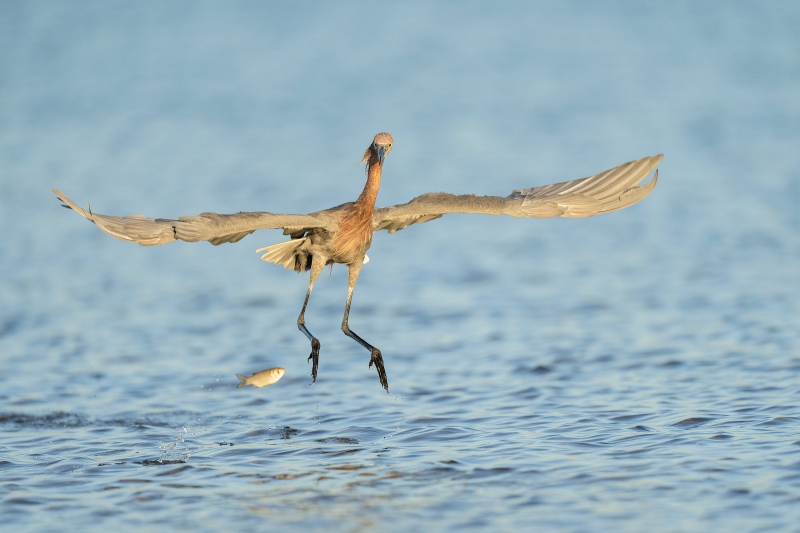
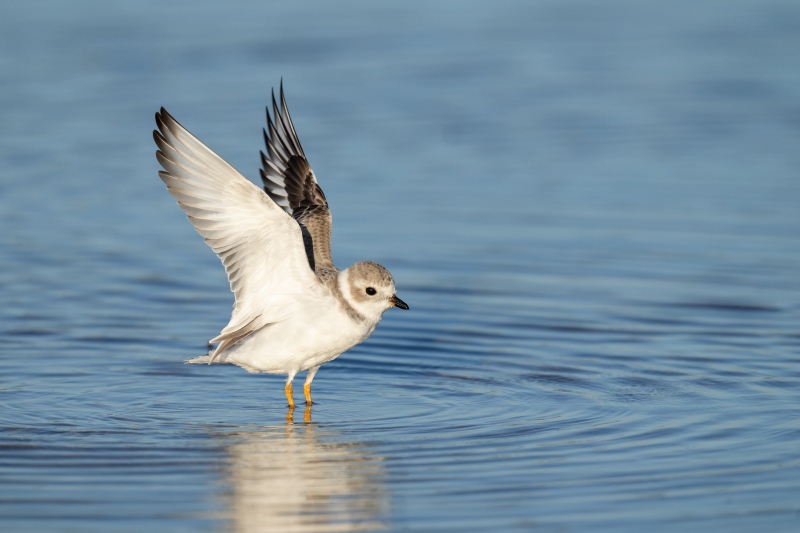
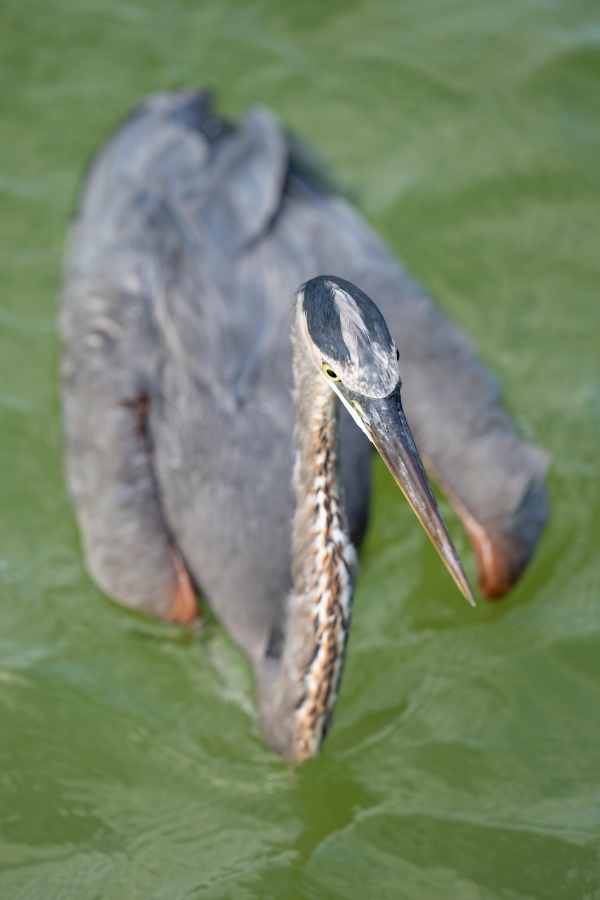
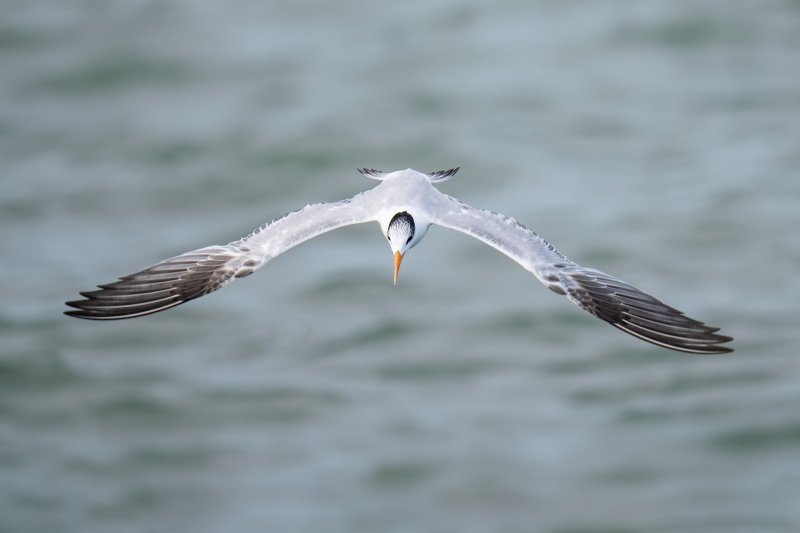
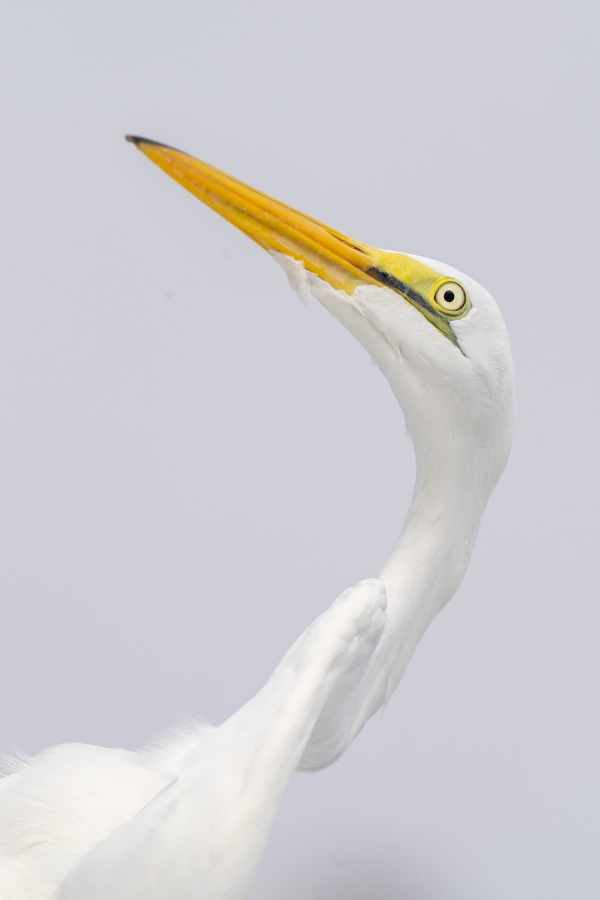
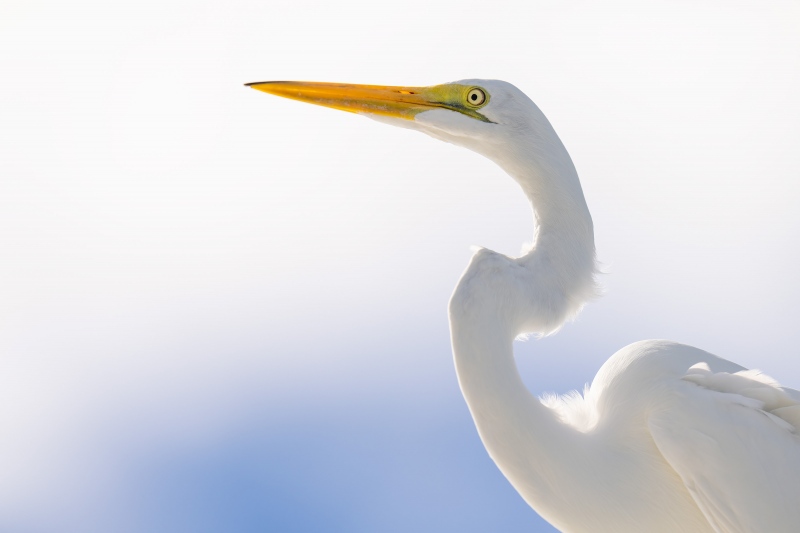













With a day off I can read today’s post and comment on the same day, which doesn’t happen often. So, in the Spotting a Good Situation section the 2nd sentence starts off with “When the turns and gulls” and then stops. Being curious, I’m left wondering.
Love the reddish egret and I like the strange perspective on the GBH.
Thanks, Keith. I hope that you enjoyed your day offered. Thanks for alerting me to the unfinished sentence. It has been fixed.
with love, artie
All 6 of these photos are good and interesting and great! No. 1 Reddish Egret dark morph dancing with fish is funny and also with the other little bird coming out of the water! No. 2 Piping Plover juvenile is good standing in the water!
For a Bad (?) session, you certainly walked away with a lot of interesting images to ponder. I liked Image #5, the Great Egret portrait as it reminded me of the socialist style propaganda posters of the 1930’s with the strong diagonals including the head pointed skyward.
Interesting comment. I sent you a mail on the propaganda business.
with love, artie
Artie
I love how you can go back in the future and also love how you can go forward into the future as in today’s first 4 images taken 10-10-2022….Time Travel, can you teach that? Love you Artie 🙂
My favorite of today’s blog is #1 i love the dance and the bait fish and #5 twisted neck and #6
the backlight and blue is really beautiful! (The other typo is jumped of the pier) (off?)
Always with love b
Thanks, Bob, for being my timekeeper. At least I was consistent. I am fixing the errors now.
with love, a
Artie
You asked to be checked on and i normally let others comment on the typo’s it is interesting to read. But i do love the blog and all the learning possibilities and find it funny in your hustle to get things posted. A few here and there are just the way life is, as life is like a box of chocolates.
Always with love b